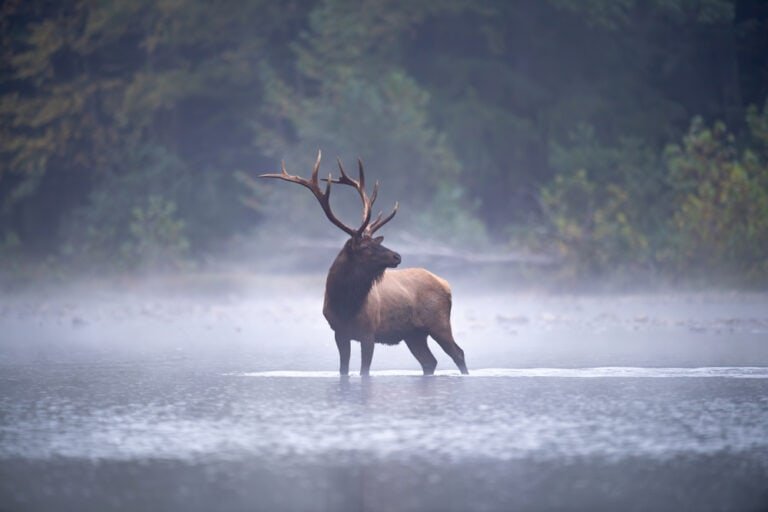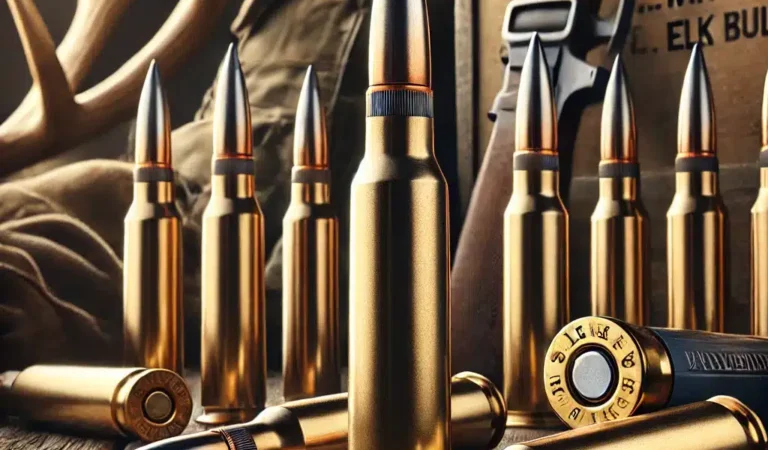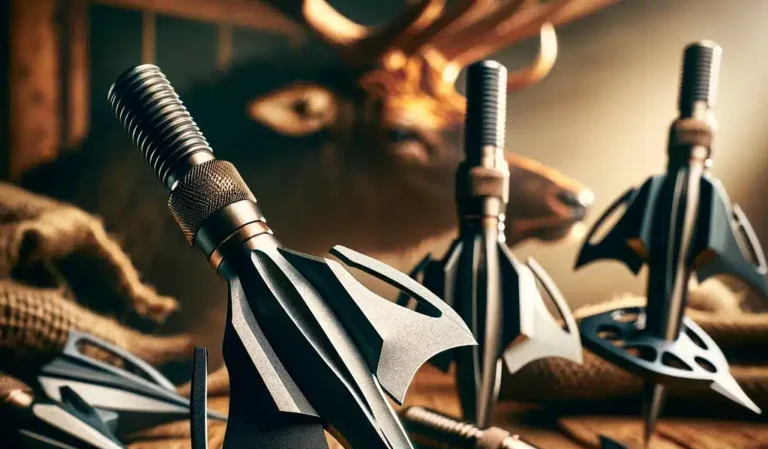Washington Elk Hunting: 5 Powerful Tricks for Hunting Success
A bull elk’s bugle echoes through the misty valleys of the Olympic Peninsula, sending shivers down your spine. At 6,000 feet up in the Cascade Range, frost crunches beneath your boots as first light reveals a massive Roosevelt bull leading his harem through an ancient grove of Douglas firs. This is Washington elk hunting.
This is elk hunting in Washington—where two distinct species of North America’s most majestic game animals roam across 68,000 square miles of wild country, from rainforest to alpine meadow, sea level, and snow-capped peaks.

Here, in the Evergreen State, you might find yourself glassing the steep slopes of the Blue Mountains at dawn, watching steam rise from a hidden wallow in the Willapa Hills, or tracking fresh signs through the old-growth forests of the Olympic National Forest.
Whether you’re pursuing the larger Roosevelt elk in the state’s western rainforests or stalking Rocky Mountain elk in the eastern highlands, Washington offers some of North America’s most challenging and rewarding elk hunting experiences.
For generations, hunters have tested their skills against Washington’s elk, and today’s opportunities are more diverse than ever. With over 60,000 Roosevelt elk and 70,000 Rocky Mountain elk calling Washington home, the state has become a premier destination for those seeking their next great hunting adventure.
But success here demands more than just showing up with a tag in your pocket—it requires intimate knowledge of the terrain, understanding of elk behavior, and mastery of hunting techniques unique to the Pacific Northwest’s varied landscapes.
In this comprehensive guide, we’ll walk you through everything you need to know to pursue Washington’s elk, from selecting the right unit for your hunting style to field-dressing your harvest in the challenging terrain of the Cascades.
Whether you’re a first-time elk hunter or a seasoned veteran of the mountains, this is your roadmap to success in one of America’s last great elk hunting destinations.
Washington’s Elk Species

Rocky Mountain Elk (Cervus canadensis nelsoni)
- Location: Eastern Washington, primarily in the Cascade Range and Blue Mountains
- Physical Characteristics:
- Bulls weigh 700-900 pounds
- Cows weigh 500-600 pounds
- Lighter colored coat with darker mane
- Antlers typically have 6-8 points per side
- Preferred Habitat:
- Mixed conifer forests
- Alpine meadows
- Open grasslands
- Elevations between 2,000-10,000 feet
Roosevelt Elk (Cervus canadensis roosevelti)
- Location: Western Washington, Olympic Peninsula, and coastal regions
- Physical Characteristics:
- Largest subspecies of North American elk
- Bulls weigh 875-1,100 pounds
- Cows weigh 600-700 pounds
- Darker brown coat
- Broader, heavier antlers
- Preferred Habitat:
- Coastal rainforests
- Old-growth forests
- River valleys
- Lowland areas up to 4,000 feet
Prime Hunting Units

Eastern Washington Hot Spots
- Blue Mountains
- Units 154 (Blue Creek)
- Units 162 (Dayton)
- Units 166 (Tucannon)
- High success rates during general season
- Cascade Range
- Units 352 (Nooksack)
- Units 360 (Bethel)
- Units 368 (Cowiche)
- Best for Rocky Mountain elk
Western Washington Hot Spots
- Olympic Peninsula
- Units 601 (Hoko)
- Units 612 (Coyle)
- Units 621 (Olympic)
- Prime Roosevelt elk territory
- Southwest Region
- Units 506 (Willapa Hills)
- Units 530 (Ryderwood)
- Units 550 (Coweeman)
- Known for trophy Roosevelt bulls
Licensing and Regulations

Resident Requirements
- Annual big game license: $50.40
- Elk license/tag: $50.40
- Hunter education certification required
- Special permits through lottery system
Non-Resident Requirements
- Annual big game license: $164.00
- Elk license/tag: $497.00
- Apply for special permits by March deadline
- Limited number of tags available
Season Dates (Typical)
- Archery:
- Early season: September 1-24
- Late season: November 21-December 8
- Modern Firearm:
- General season: October 29-November 6
- Late season: November 5-15
- Muzzleloader:
- Early season: October 1-7
- Late season: November 25-December 8
Advanced Hunting Strategies

Pre-Season Scouting
Digital Scouting
- Use OnX Hunt or similar GPS apps
- Study topographical maps
- Identify potential bedding areas
- Mark water sources and food plots
Physical Scouting
- Look for fresh tracks and droppings
- Identify active wallows
- Find heavily used game trails
- Document rubs and scrapes
- Mark water sources and food plots
Calling Techniques
Early Season
- Soft cow calls
- Location bugles
- Social herd sounds
Peak Rut
- Aggressive bugling
- Challenge calls
- Cow estrus calls
- Satellite bull tactics
Late Season
- Minimal calling
- Soft cow mews
- Focus on feeding areas
Still Hunting Tactics
Morning Strategy
- Position near bedding areas
- Watch thermal currents
- Focus on east-facing slopes
Midday Approach
- Still hunt thick cover
- Monitor water sources
- Check north-facing slopes
Evening Tactics
- Set up near feeding areas
- Watch meadow edges
- Monitor west-facing slopes
Essential Gear List

Weapons and Optics
Rifle Recommendations
- .300 Win Mag
- .308 Winchester
- 7mm Remington Magnum
- Minimum 160-grain bullets
Archery Requirements
- Minimum 50-pound draw weight
- Fixed-blade broadheads
- Cut-on-contact designs preferred
Optics
- 10×42 binoculars
- 15-45x spotting scope
- Range finder (minimum 1000 yards)
Clothing System
- Base Layer
- Merino wool preferred
- Synthetic alternatives acceptable
- Multiple sets for extended hunts
- Insulation Layer
- Down or synthetic puffy
- Fleece mid-layer
- Wool sweater
- Outer Layer
- Gore-Tex or similar waterproof material
- Quiet fabric for stalking
- Reinforced knees and seat
Essential Equipment
- Heavy-duty backpack (3000+ cubic inches)
- GPS device with extra batteries
- Emergency shelter
- First aid kit
- Game bags
- Knife and saw kit
- Fire starting materials
- Water filtration system
Field Care and Processing

Initial Field Dressing
- Immediately After Harvest
- Confirm tag attachment
- Take harvest photos
- Begin field dressing within 30 minutes
- Field Dressing Steps
- Remove internal organs
- Cool meat quickly
- Keep quarters clean
- Use game bags
Meat Preservation
- Keep quarters off the ground
- Hang in shade when possible
- Use rope system for hanging
- Monitor meat temperature
Pack Out Strategies
- Solo Hunter
- Quarter and debone
- Multiple trips likely needed
- Mark GPS waypoints
- Team Approach
- Divide meat among hunters
- Use frame packs
- Establish relay system
Conservation and Ethics

Conservation Efforts
- Support local conservation groups
- Participate in habitat improvement
- Report illegal activities
- Share harvest data
Ethical Considerations
- Take ethical shots only
- Practice shooting year-round
- Minimize environmental impact
- Respect private property
- Follow fair chase principles
Resources and Contacts
Important Contacts
- WDFW Main Office: (360) 902-2200
- Poaching Hotline: 1-877-933-9847
- Hunter Education: (360) 902-8111






